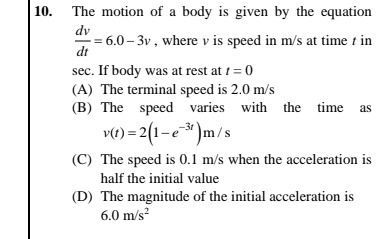Question
Question: The motion of a body is given by the equation $\frac{dv}{dt} = 6.0 - 3v$, where $v$ is speed in m/s ...
The motion of a body is given by the equation dtdv=6.0−3v, where v is speed in m/s at time t in sec. If body was at rest at t=0

The terminal speed is 2.0 m/s
The speed varies with the time as v(t)=2(1−e−3t) m/s
The speed is 0.1 m/s when the acceleration is half the initial value
The magnitude of the initial acceleration is 6.0 m/s²
A, B, D
Solution
The motion of the body is described by the differential equation: dtdv=6.0−3v
Given initial condition: at t=0, v=0.
Let's analyze each option:
A) The terminal speed is 2.0 m/s
Terminal speed (vt) is reached when the acceleration becomes zero, i.e., dtdv=0.
Setting the given equation to zero:
6.0−3vt=0
3vt=6.0
vt=36.0=2.0 m/s
Thus, option (A) is correct.
B) The speed varies with the time as v(t)=2(1−e−3t) m/s
To find the speed as a function of time, we need to solve the differential equation:
dtdv=6−3v
Separate the variables:
6−3vdv=dt
Integrate both sides. To make integration easier, factor out -3 from the denominator:
−3(v−2)dv=dt
∫v−2dv=∫−3dt
ln∣v−2∣=−3t+C
v−2=Ae−3t (where A=±eC)
Now, apply the initial condition: at t=0, v=0.
0−2=Ae−3(0)
−2=A⋅1
A=−2
Substitute A=−2 back into the equation:
v−2=−2e−3t
v(t)=2−2e−3t
v(t)=2(1−e−3t) m/s
Thus, option (B) is correct.
C) The speed is 0.1 m/s when the acceleration is half the initial value
First, calculate the initial acceleration (ainitial). Initial acceleration occurs at t=0, when v=0.
ainitial=(dtdv)t=0=6.0−3(0)=6.0 m/s²
Half the initial acceleration is 26.0=3.0 m/s².
Now, find the speed (v) when the acceleration is 3.0 m/s²:
3.0=6.0−3v
3v=6.0−3.0
3v=3.0
v=1.0 m/s
The option states the speed is 0.1 m/s, which is incorrect.
Thus, option (C) is incorrect.
D) The magnitude of the initial acceleration is 6.0 m/s²
As calculated in option (C), the initial acceleration is when t=0 (and v=0):
ainitial=6.0−3(0)=6.0 m/s²
Thus, option (D) is correct.
Final Answer: The correct options are (A), (B), and (D).
